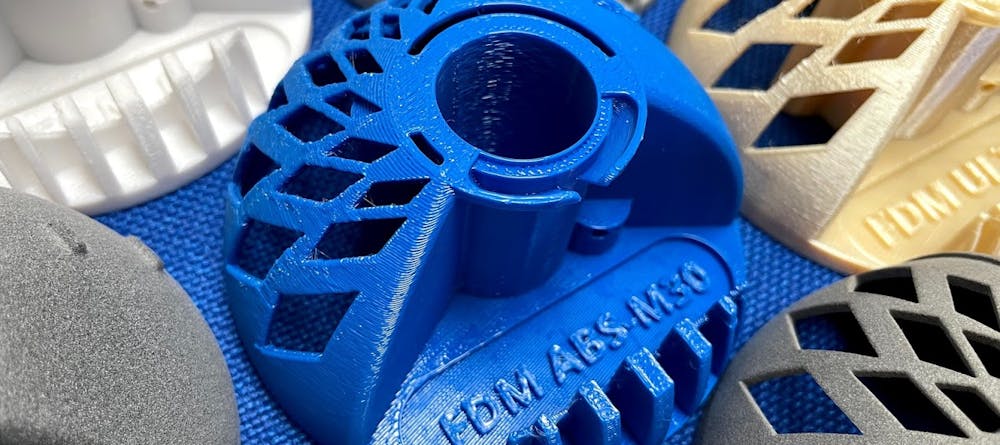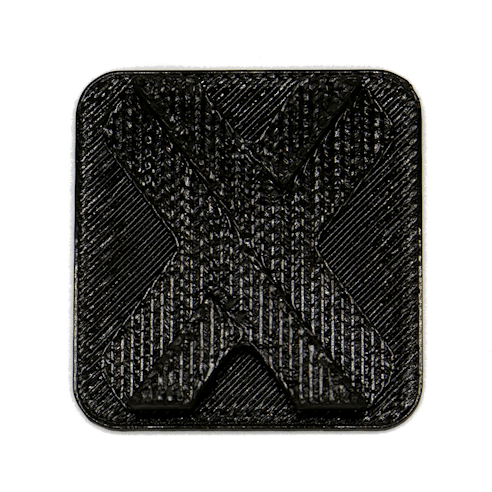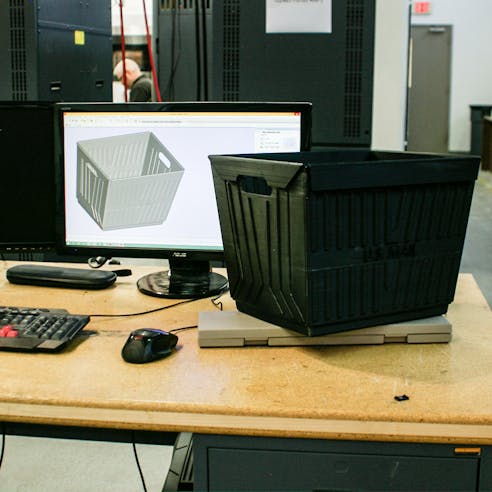ABS 3D Printing Service
Get instant online quotes on 3D Printed ABS parts. Free shipping on all US orders. ISO 9001:2015, ISO 13485, IATF 16949:2016, and AS9100D certified.

About 3D Printing ABS
ABS (acrylonitrile butadiene styrene) is one of the strongest standard plastics used in FDM 3D printing and has good mechanical properties, such as good resilience and impact resistance. The ABS plastics listed below have the advantage of being stronger than standard ABS and as such, improve on an already strong material. It must be noted that FDM parts are anisotropic, meaning that material strength differs depending on how the part is loaded.
ABS is a popular material that can produce high-strength and excellent impact-strength parts in a range of industries for both prototyping and end-use.
Applies to US-based production only.
FDM ABS-M30
This grade of ABS filament has a high-strength formulation that makes it up to 70% stronger than standard ABS filament. It also offers a better interlayer bond strength, allowing for increased strength in the Z-axis. Applications can include tool fixtures and low-volume production parts.
| Tensile Strength (MPa) | Elongation at Break (%) | Hardness (Rockwell) | Heat Deflection Temperature (℃) | Glass Transition (℃) |
|---|---|---|---|---|
Tensile Strength (MPa) 31 | Elongation at Break (%) 7 | Hardness (Rockwell) 109.5 | Heat Deflection Temperature (℃) 82 | Glass Transition (℃) 108 |
FDM ABS-ESD7
This grade of ABS is electrostatic-dissipative which means it has special anti-static properties. This is possible thanks to the inclusion of extra carbon filler in the formulation. This has the strength benefits of ABS while also allowing it to be used alongside sensitive electronics without the risk of static discharges damaging delicate components. This makes it ideal for electronic housings and fixtures for electronic components.
| Tensile Strength (MPa) | Elongation at Break (%) | Hardness (Rockwell) | Heat Deflection Temperature (℃) | Glass Transition (℃) |
|---|---|---|---|---|
Tensile Strength (MPa) 36 | Elongation at Break (%) 3 | Hardness (Rockwell) 109.5 | Heat Deflection Temperature (℃) 82 | Glass Transition (℃) 108 |
FDM ABS-M30i
This grade of ABS is specially formulated to be biocompatible in accordance with ISO 10993 USP Class VI. It can also be gamma- or Eto-sterilized. It is important to understand even though the material is certified as biocompatible, that does not mean the end product will automatically be compliant. This material can be used to make functional prototypes, food packaging, or end-use components.
| Tensile Strength, Yield (MPa) | Elongation at Break (%) | Hardness (Rockwell) | Heat Deflection Temperature (℃) | Glass Transition (℃) |
|---|---|---|---|---|
Tensile Strength, Yield (MPa) 36 | Elongation at Break (%) 4 | Hardness (Rockwell) 109.5 | Heat Deflection Temperature (℃) 82 | Glass Transition (℃) 108 |
FDM ABSi
This grade of ABS is translucent and therefore allows monitoring of material or fluid flow inside a prototype to help analyze a potential product's performance. This material is also stronger than normal ABS, so the translucent capability does not hinder its mechanical performance. It can be used in prototypes that require light transmission or flow monitoring.
| Tensile Strength (MPa) | Elongation at Break (%) | Hardness (Rockwell) | Heat Deflection Temperature (℃) | Glass Transition (℃) |
|---|---|---|---|---|
Tensile Strength (MPa) 37 | Elongation at Break (%) 4.4 | Hardness (Rockwell) 108 | Heat Deflection Temperature (℃) 73 | Glass Transition (℃) 116 |
Finishes
ABS plastic printing using FDM technology does not typically have a wide range of possible surface finishes. There are, however, a wide range of colors available. In addition to this, some basic surface finishes are listed below.
Standard: Support structures are removed and some light sanding is performed at the support locations. FDM parts will generally show clear layer lines known as stepping. If a smooth surface finish is required right off the machine, then they should consider other 3D printing technologies.
Custom: Custom surface finishes like painting and additional sanding can be requested.

Cost-saving Design Tips
To save money with ABS printing, follow these cost-saving design tips:
DFM: ABS 3D printing with FDM technology requires special considerations when designing parts. FDM machines construct parts from the bottom up, so large overhangs will require support. Large internal cavities are not ideal as support structures cannot be removed. This can, however, be overcome with special soluble supports, though these add complexity and cost to the design. In addition to this, care must be taken when designing load-bearing components as FDM parts are generally weakest in the Z-axis due to the bond strength between layers.
Choose the right ABS: The above-listed ABS materials are each designed for specific use cases and should only be used when required. For example, biocompatible ABS is not needed for a tooling fixture and would increase the overall cost of the part for no reason.

